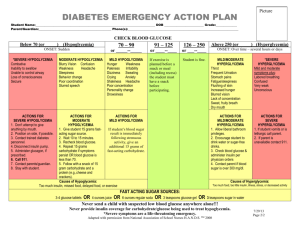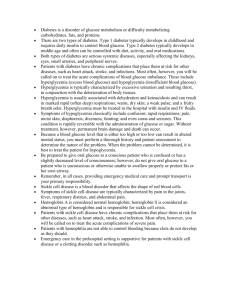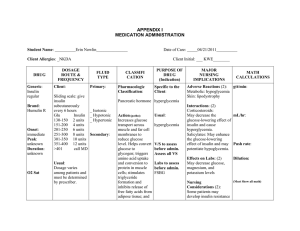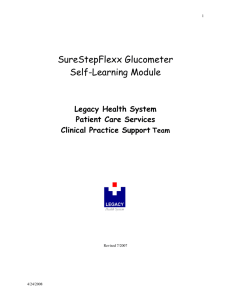Indications for Blood Glucose Testing
advertisement
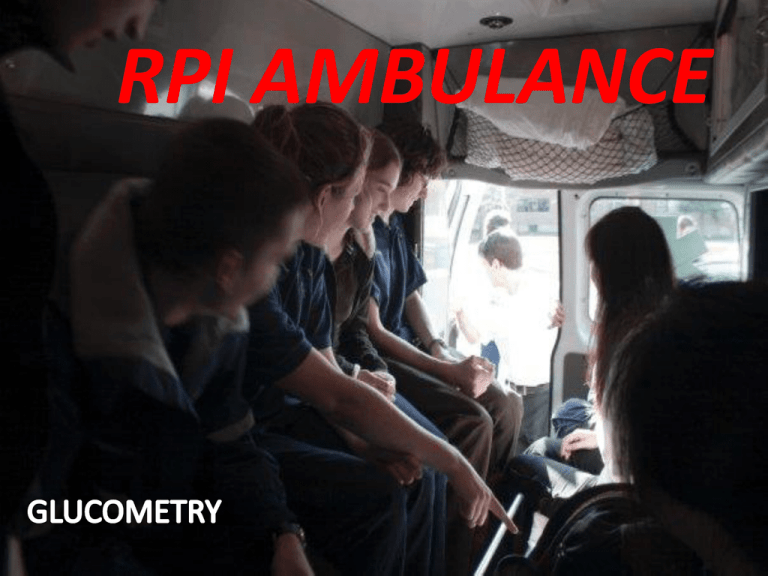
RPI AMBULANCE Topics to Cover • Indications for Blood Glucose testing • Symptoms/Differences of Hypoglycemia and Hyperglycemia • Treatment for hypoglycemia and hyperglycemia • Required equipment to test Blood Glucose levels • How to use the equipment Indications for Blood Glucose Testing • • • • • • • • • • • Altered Mental Status Abnormal Behavior Syncope Seizures Diabetic Related Emergency (or if someone has a history of diabetes, and has AMS) Stroke Overdose of hypoglycemic agents (e.g. Insulin) Unconscious or Unresponsive Patients Poor nutritional status or fasting General Illness Have symptoms of Hypoglycemia/Hyperglycemia Hypoglycemia • Hypoglycemia is having abnormally low blood glucose levels. (Under 80mg/dL) • Symptoms of low BG include: fatigue, mental confusion (AMS), Unconsciousness or Unresponsiveness, Diaphoresis (cool, moist, clammy), Dizziness/light-headedness. • Patients with low BG may APPEAR drunk. This is why it is important to take the blood glucose of any pt who you suspect to be drunk. Even if they admit to drinking. • *note that although it is rare, non-diabetic patients can have low blood sugar. Hyperglycemia • Hyperglycemia is having abnormally high blood glucose (above 120mg/dL). • Symptoms/complications with high BG usually occur when the BG is much higher than 120, this can result in a diabetic coma or ketoacidosis. • Symptoms of high BG include: Frequent urination, increased thirst or dry mouth, shortness of breath, breath that smells fruity (from the ketones), nausea and vomiting. Treatment • EXACT REMO PROTOCOL for diabetic emergency: – ABCs and Vitals. – Airway management and appropriate oxygen therapy. – Check blood glucose level, if equipped. – If blood glucose is known or suspected to be low and patient is able to self administer and swallow on command, give oral glucose one unit dose. – If blood glucose is CONFIRMED to be high do not administer oral glucose. – Call for ALS intercept if unable to swallow on command, or mental status remains altered following administration of oral glucose. Treatment • Just as a reminder, hypoglycemia and hyperglycemia are both diabetic emergencies. Don’t forget ALS! • Treatment for hypoglycemia (as BLS): Oxygen, if pt can swallow/self administer on command then give pt one unit of liquid glucose (a tube), Treat for shock! • As any other medication, reassess the pt before and after administered including vitals. Retake the BG a minute or two after administration. • Treatment of hyperglycemia (as BLS): Transport, oxygen, monitor pt. Keep in mind that ALS can’t do anything else for the pt than that unless the BG is over 400mg/dL The Equipment! • • • • • Blood Glucose Test Machine (Precision Xtra) Test Strips made for Precision Xtra Lancets Alcohol Preps 4x4 Gauze or Band-Aids Interactive Demo. • http://www.abbottdiabetescare.com/static_di visional/abbott_diabetes_care/application/ht ml/precision_xtra_demo.html That’s within normal range! *Open link with Internet Explorer Calibrating the Glucometer • The Glucometer has to be re-calibrated every time new test strips are being used. This is to ensure that they are reading accurately. • Make sure the five digit code on the calibrator strip matches the one on the test strips. • Insert the calibrator(the side with the bars) into the monitor. • Verify that the five digit lot number on monitor matches the one on the calibrator. Control Testing • Control testing is to ensure that our glucometer is working properly. • After calibrating the new test strips, insert a test strip into the glucometer. The side with the bars go into the slot on the bottom side of the monitor, the side with the “white box” is where the sample (blood or control solution) goes. • Wait for the symbols indicating the monitor is ready for the control/blood. • Shake the control solution, then apply a drop to the end of the test strip. • Wait for count down to end, then verify that the number is in the correct range. Taking a Blood Sugar • Start by cleaning the area you plan to lance with an alcohol prep. This area should be any of the finger tips excluding the thumb. • Open the test strip and band-aid. Insert the test strip just enough so it stays in but does not show the applying blood symbols. • Use a lancet to lance the fingertip. • Push the strip in till appropriate screen is shown and place blood on end of test strip. • Wait for countdown to end. If normal, BG will be between 80 and 120mg/dL. • Put a 4x4 or band-aid on finger. Special Considerations • If it is cold outside, or the patients hands are cold, it may be difficult to get enough blood to apply to the test strip! Try to warm up patients hands! • Remember: Patients can refuse any treatment you want to give them. If patient refuses having their BG taken and they are alert and oriented, document and tell the hospital staff. That’s it! Thanks! Brought to you by Lance

